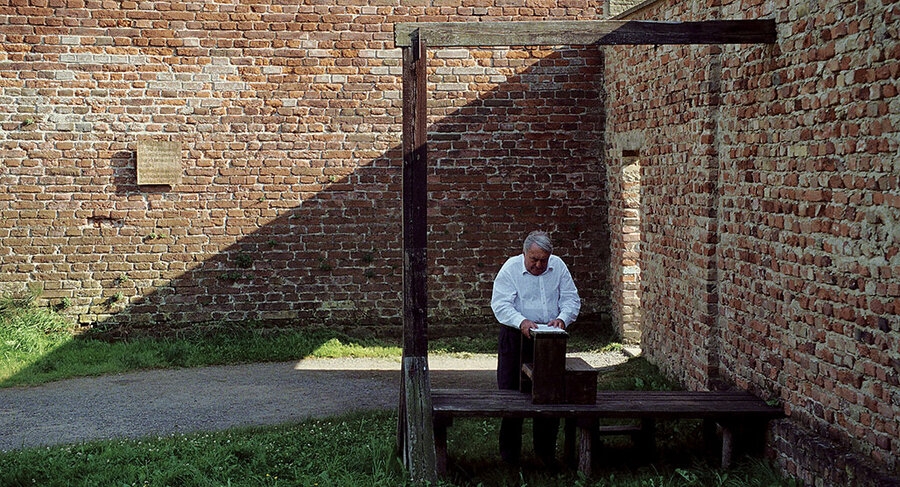'The Last of the Unjust' probes a historical horror
Loading...
In 1985 Claude Lanzmann released his Holocaust documentary “Shoah,” all 9-1/2 hours of it, and forever altered our conception of that catastrophe. The overwhelming accretion of testimony from participants and victims was a singular act of historical scholarship, but it was also an epic dirge – a prayer for both the living and the dead.
As epic as that film was, quite a bit of footage was left on the cutting room floor. From that mass Lanzmann has excavated a major new film, “The Last of the Unjust,” which runs 3 hours and 40 minutes. It consists almost entirely of a week-long interview Lanzmann conducted in 1975 with the 70-year-old Benjamin Murmelstein, a Viennese rabbi who was the final and only surviving Jewish elder in the Theresienstadt Nazi camp located 40 miles north of Prague in what was then Czechoslovakia. (Elders were the Nazi-appointed heads of the Jewish councils set up to enforce Hitler’s bidding.) He served from December 1944 to May 1945. His two predecessors were killed, one at the camp, the other after he was transferred to Auschwitz. Murmelstein, who died in 1989, remains highly controversial. For some, his survival, when so many perished, is, by definition, morally suspect. Refusing to flee after the Soviet liberation of the camp, he was arrested and imprisoned by the Czech authorities for 18 months before being acquitted of all charges. He went into self-imposed exile in Rome and wrote a book in 1961 about his experiences at Theresienstadt. The hatred of many Holocaust survivors and historians remains focused on him. (The Jewish scholar Gershom Scholem called for him to be hanged.) Despite his deep desire to do so, Murmelstein never visited Israel.
Lanzmann is in some ways an equal presence in “The Last of the Unjust.” (In “Shoah” he was essentially behind the scenes.) In the 1975 footage, he sits with the expansive, spiky, eloquent Murmelstein, digging into his testimony and countering his recollections. At 87, Lanzmann is filmed revisiting old haunts in Vienna and Czechoslovakia, speaking aloud from both his own notes and from Murmelstein’s memoirs. The two eras are intercut seamlessly.
Lanzmann served as a young man in the French Resistance. He is a good match for Murmelstein. Despite the filmmaker’s inquisitorial instincts, it’s obvious by the end that he has, in some ways, bonded with his subject. “The Last of the Unjust” is in no way an exoneration of the rabbi, but it does allow him to lay out his story in a way that makes emotional sense. The question Murmelstein poses to us is essentially, Who among you are saints? “An elder of the Jews can be condemned,” he says. “In fact, he must be condemned. But he can’t be judged. Because one cannot take his place.”
The Theresienstadt camp, opened in 1941, was notorious for being Hitler’s “gift to the Jews” – a “model ghetto” that was supposed to show the world, specifically the International Red Cross, how lovely things were for the Jews being incarcerated. A 1944 Nazi documentary (which Lanzmann has also made a movie about) shows the Jews studying, sewing, playing soccer, attending concerts and lectures, and eating hearty meals. The reality is that 33,000 of the 140,000 prisoners died of starvation and disease, while 90,000 others were deported to such extermination camps as Auschwitz-Birkenau. Ninety percent of the ghetto’s 15,000 children did not survive.
Murmelstein, who worked under Adolf Eichmann, defends his bullying tactics. Charged with withholding food from some of his fellow Jews, he explains this was only to force them to be inoculated against typhus. Condemned for propping up the “embellishments” of the “model ghetto,” he responds, “If they had to show us, they could not kill us.” Of Hannah Arendt’s notorious description of Eichmann as the personification of “the banality of evil,” Murmelstein is withering: “He was a demon.”
Murmelstein stands condemned by those who see the morality of his predicament in strict shades of black and white. But it is the great achievement of “The Last of the Unjust” that it presents the awfulness of this history in all its ambiguousness and complexity. When Lanzmann charges Murmelstein with exhibiting little feeling for the horrors he is expounding, he counters by saying, “If a surgeon starts crying over his patient, he kills him.”
There is no need for Murmelstein to break down here. In “The Last of the Unjust,” it’s as if the whole world is weeping. Grade: A (Rated PG-13 for some thematic material.)







